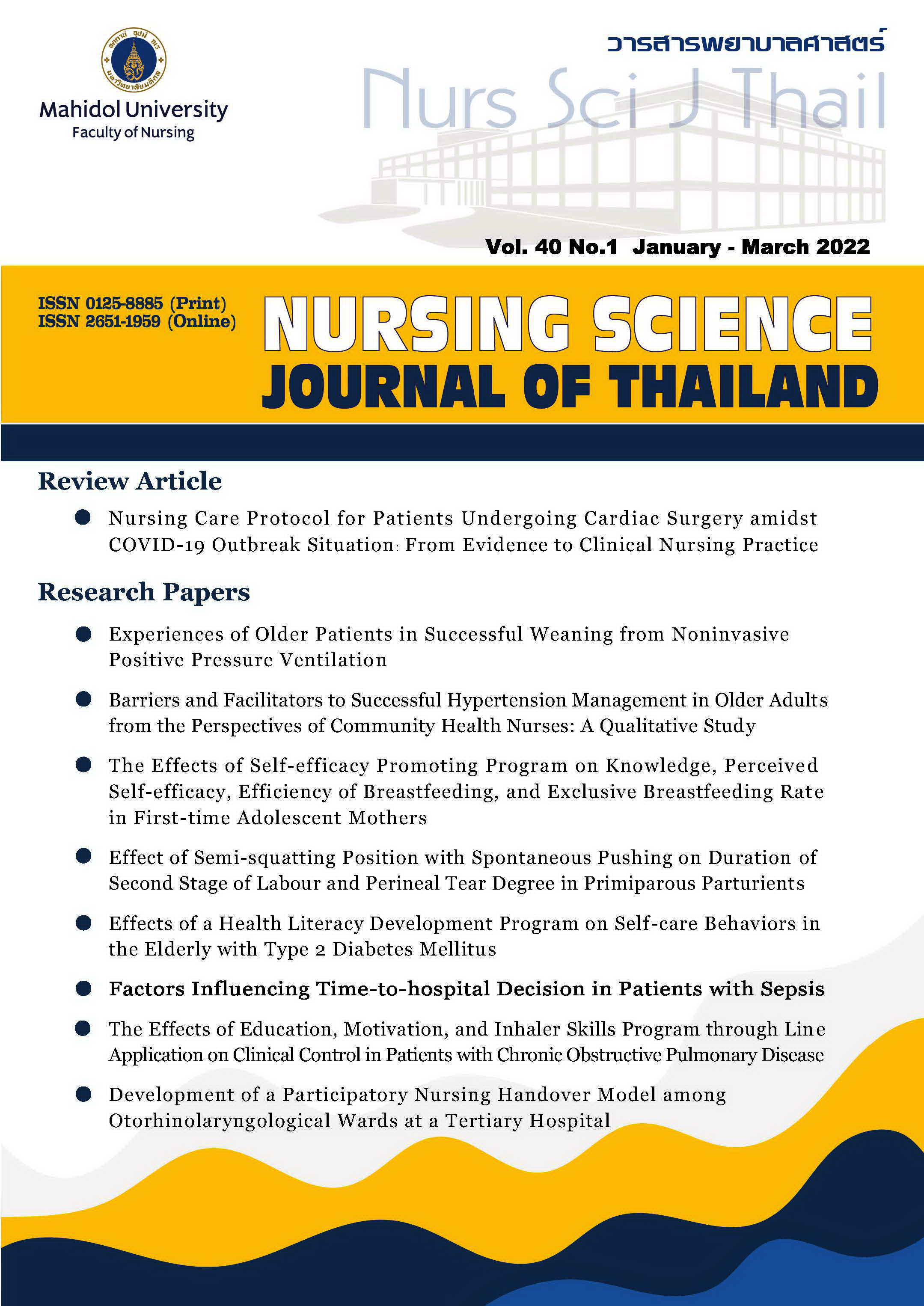The Effects of Self-efficacy Promoting Program on Knowledge, Perceived Self-efficacy, Efficiency of Breastfeeding, and Exclusive Breastfeeding Rate in First-time Adolescent Mothers
Main Article Content
Abstract
Purpose: To study the effects of self-efficacy promoting program on knowledge, perceived self-efficacy, efficiency of breastfeeding and exclusive breastfeeding rate in first-time adolescent mothers
Design: Quasi-experimental research.
Methods: The sample consisted of first-time adolescent mothers with normal delivery without conditions of neither the mothers nor the infants had breastfeeding barriers. The convenience sample was divided into two groups, with 26 subjects each. The experimental group received breastfeeding knowledge through demonstrations and returns demonstrations for breastfeeding. Data was collected by using the breastfeeding knowledge questionnaire, perceived self-efficacy questionnaire, efficiency of breastfeeding questionnaire, and breastfeeding questionnaire. Data was analyzed using Independent t-test, Man-Whitney U Test, and Chi-square statistics.
Main findings: The study findings revealed that the adolescent mothers 76.9% had low learning experience with media learning. Accessing quality of animation media “breastfeeding for First-Time Adolescent Mothers” was good (73.1%). The experimental group had higher knowledge in breastfeeding, perceived self-efficacy, efficacy of breastfeeding before discharge from the hospital was statistically different (p < .05). Moreover, the experimental group had higher knowledge in breastfeeding, perceived self-efficacy at 8 weeks was statistically different (p < .001). In addition, the experimental group had higher exclusive breastfeeding rate at 4, 6, 8 weeks was statistically different (p < .001).
Conclusion and recommendations: Self-efficacy promoting program was effective to increase knowledge, perceived self-efficacy, efficiency of breastfeeding, and exclusive breastfeeding rate among first-time adolescent mothers. Therefore, nursing and related health professionals could apply this program to promote efficiency of breastfeeding in first-time adolescent mothers.
Article Details

This work is licensed under a Creative Commons Attribution-NonCommercial-NoDerivatives 4.0 International License.
Copyright Notice: Nursing Science Journal of Thailand has exclusive rights to publish and distribute the manuscript and all contents therein. Without the journal’s permission, the dissemination of the manuscript in another journal or online, and the reproduction of the manuscript for non-educational purpose are prohibited.

Disclaimer: The opinion expressed and figures provided in this journal, NSJT, are the sole responsibility of the authors. The editorial board bears no responsibility in this regard.
References
World Health Organization. World health statistics overview 2019: monitoring health for the SDGs, sustainable development goals [Internet]. Geneva, Switzerland: WHO; 2019 [cited 2021 May 13]. Available from: https://apps.who.int/iris/handle/10665/311696.
Office of Reproductive Health, Ministry of Public Health. Annual report 2020 [internet]. Nonthaburi: Office of Reproductive Health, Ministry of Public Health; 2020 [cited 2021 Aug 4]. Available from: https://rh.anamai.moph.go.th/web-upload/7x027006c2abe84e89b5c85b44a692da94/202101/m_news/32053/200929/file_download/5499b750564075b590cc442f64caae41.pdf. (in Thai).
Ganchimeg T, Ota E, Morisaki N, Laopaiboon M, Lumbiganon P, Zhang J, et al. Pregnancy and childbirth outcomes among adolescent mothers: a World Health Organization multicountry study. BJOG. 2014;121 Suppl 1:40-8. doi: 10.1111/1471-0528.12630.
Lawrence RA, Lawrence, RM. Breastfeeding: a guide for the medical profession. 9th ed. Philadelphia: Elsevier; 2021. 1088 p.
Victora CG, Bahl R, Barros AJ, França GV, Horton S, Krasevec J, et al. Breastfeeding in the 21st century: epidemiology, mechanisms, and lifelong effect. Lancet. 2016;387(10017):475-90. doi: 10.1016/S0140-6736(15)01024-7.
United Nations International Children’s Emergency Fund. Breastfeeding [Internet]. Geneva: UNICEF; 2015 [cited 2019 May 20]. Available from: http://www.unicef.org/nutrition/index_24824.html.
Topothai C, Tangcharoensathien V. Achieving global targets on breastfeeding in Thailand: gap analysis and solutions. Int Breastfeed J. 2021;16(1):38. doi: 10.1186/s13006-021-00386-0.
National Statistical Office of Thailand. The child and women situation survey project in Thailand 2019, the final result. Bangkok: National Statistical Office of Thailand; 2020. 502 p. (in Thai).
Puapornpong P, Raungrongmorakot K, Manolerdtewan W, Ketsuwan S, Wongin S. Teenage pregnancy and exclusive breastfeeding rates. J Med Assoc Thai. 2014;97(9):893-8.
Leclair E, Robert N, Sprague AE, Fleming N. Factors associated with breastfeeding initiation in adolescent pregnancies: a cohort study. J Pediatr Adolesc Gynecol. 2015;28(6):516-21. doi: 10.1016/j.jpag.2015.03.007.
Apostolakis-Kyrus K, Valentine C, DeFranco E. Factors associated with breastfeeding initiation in adolescent mothers. J Pediatr. 2013;163(5):1489-94. doi: 10.1016/j.jpeds.2013.06.027.
Bundach W, Rithphol P, Wannapornsiri C. Effects of Using the perceived self-efficacy program on breast feeding among teenage pregnancy, Kamphaeng Phet Province. Journal of Nursing and Health Science. 2014;8 Suppl 3:65-79. (in Thai).
Prasopkittikun T, Sangperm P. Self-efficacy promoting interventions for breastfeeding outcomes: an integrative review of research conducted in Thailand. Pacific Rim Int J Nurs Res Thail. 2017;21(1):44-8.
Javorski M, Rodrigues AJ, Dodt RCM, de Almeida PC, Leal LP, Ximenes LB. Effects of an educational technology on self-efficacy for breastfeeding and practice of exclusive breastfeeding. Rev Esc Enferm USP. 2018;52:e03329. doi: 10.1590/S1980-220X2017031803329.
Otsuka K, Taguri M, Dennis C-L, Wakutani K, Awano M, Yamaguchi T, et al. Effectiveness of a breastfeeding self-efficacy intervention: do hospital practices make a difference? Matern Child Health J. 2014;18(1):296-306. doi: 10.1007/s10995-013-1265-2.
Yimyam S, Khnsung P. Breastfeeding promotion among adolescent mothers. Nursing Journal. 2019;46(1):239-50. (in Thai).
Bandura A. Self-efficacy: toward a unifying theory of behavioral change. Psychol Rev. 1977;84(2):191-215. doi: 10.1037//0033-295x.84.2.191.
Glass GV. Primary, secondary, and meta-analysis of research. Educ Researcher. 1976;5(10):3-8. doi: 10.2307/1174772.
Gray JR, Grove SK, Sutherland S. Burns and Grove’s the practice of nursing research. Appraisal, synthesis and generation of evidence. 8th ed. St. Louis, Missouri: Elsevier; 2017. 736 p.
Dennis C-L. The breastfeeding self‐efficacy scale: psychometric assessment of the short form. J Obstet Gynecol Neonatal Nurs. 2003;32(6):734-44. doi: 10.1177/0884217503258459.
Thussanasupap B. The effects of systematic instructional program on breastfeeding self-efficacy, nipple pain, nipple skin changes and incision pain of cesarean mothers [master’s thesis]. Bangkok: Mahidol University; 2006. 110 p. (in Thai).
Catipovic M, Voskresensky BT, Rokvic S, Grguric J. Adolescents’ knowledge of breastfeeding and their intention to breastfeed in the future. Children. 2017;4(6):51. doi: 10.3390/children4060051.
Jensen D, Wallace S, Kelsay P. LATCH: a breastfeeding charting system and documentation tool. J Obstet Gynecol Neonatal Nurs. 1994;23(1):27-32. doi: 10.1111/j.1552-6909.1994.tb01847.x.
Khurshid F, Noushad B, Spanjers IA, Al-Darwashi J. Concept animation-a potential instructional scaffolding. MedEdPublish. 2018;1:1-9. doi: 10.15694/mep.2018.0000153.1.
Hartney N, Dooley D, Nagle C. Using animation to teach breastfeeding physiology: a proof of concept study. Int Breastfeed J. 2021;16(1):1-9. doi: 10.1186/s13006-021-00368-2.
Chansiri S, Phahuwatanakorn W, Yusamran C. Influences of breastfeeding attitude, subjective norm, and self-efficacy on intention to exclusive breastfeeding among teenage pregnant women. Nursing Science Journal of Thailand. 2017;35(4):49-60. (in Thai).


